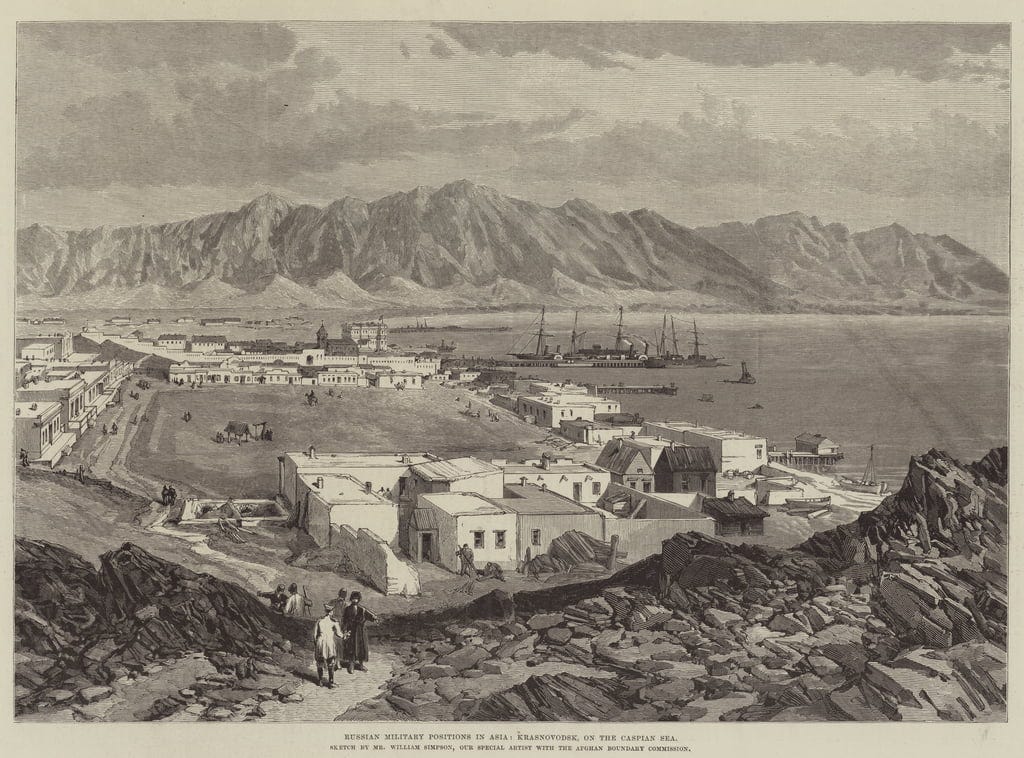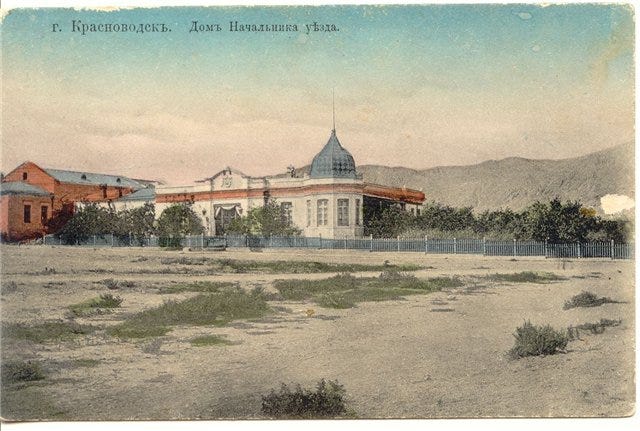Krasnovodsk - Evgeny Belozersky, 1886
Translation of a visit to Russian's outpost on the Caspian shore, on the edge of the Turkmen Steppes
Translator’s Introduction
Below is a translated excerpt about the port town of Krasnovodsk, from the travelogue Письма из Персии от Баку до Испагани (Letters from Persia, from Baku to Isfahan), 1886, by Evgeny Mikhailovich Belozersky. The original text, in the pre-1917 reform script can be found here. The source for the translation, in the reformed script, can be found here.
Krasnovodsk (“Red river”) was originally founded in 1717, at the mouth of the former Uzboy River, a now dried up extension of the Amu-Darya River (the Oxus in ancient times), which flowed into the Caspian Sea. The fortress was first built by Prince Alexander Bekovich-Cherkassky, during his failed campaign to conquer the Khanate of Khiva, which is located nearly 800 kilometers inland from the coast.
With the failure of the expedition the outpost was abandoned, but was re-founded by Russia in 1869, during its later, more successful attempt to conquer Khiva. Krasnovodsk became Russia’s main base for its campaigns to conquer the nomadic Turkmen. Later it became the terminus port for the Trans-Caspian Railway, and Central Asian cotton was shipped from here and sent up the Volga River to textile factories in Russia’s European heartland. Following the collapse of the Soviet Union and the independence of Turkmenistan, the city was renamed to Turkmanbashi (“Father of the Turks”), by the first president of independent Turkmenistan Saparmurat Niyazov, who also assumed the title “Turkmenbashi”.
This is a very short excerpt, but nicely outlines the town, and even captures a sense of mystery. There is a romantic feeling to the idea of a remote outpost on the coast of an inland sea, on a distant, desert steppe land. The Turkmen were rampant slave raiders, and were some of the most formidable opponents Russia faced in its conquest of Central Asia. The knowledge of the Turkmen steppes laying beyond the mountains that guard the fortress would certainly have had both a sense of mystery and ominous foreboding for the Russian colonialists at the time. For this reason, this text reminded me of the excellent novel “The Opposing Shore” by Julien Gracq. For more on the early history of Russian-Turkmen relations, I highly recommend “Russian-Turkmen Encounters: The Caspian Frontier before the Great Game” by Peter Poullada.
Krasnovodsk
Having stayed in Baku for a few days, my Persian companion Mirza Zhdafar and I headed off to Meshedesser1 through our2 Krasnovodsk and Chikishlyar3 on the steamship “Alexander II”. Krasnovodsk – this is a small fort, located across the bay that is also named as such. Imagine yourself at the feet of a square-chain of red mountains, enclosed by thin walls, smeared with clay, with two gates – one to the sea, and the other to the left-north side of the fortress; above the gates is a large black eagle with outstretched wings.4 In front of the wall to the right is the house of the commandant, and to the left is a small wooden church and a desalination machine, making sea water fit for drink through evaporation – there is no natural fresh water in this place. Located outside the northern gate is a street with thirty privately own shops and taverns. Right next to the fortress is a military club and a small garden next to it, which, despite all the efforts of the officers, is badly maintained due to a lack of water, and all this is located at the feet of the red, barren, naked mountains that stretch out along the shore. Behind which begins the Turkmen steppes, that was recently still scary but now is cut through by our Trans-Caspian railroad; and the population of these steppes – the energetic bronze Turkmen, with a powerfully developed brow, with a quick glance of their small eyes, in a papakha5 or Tatar yarmulkes6 (arakchi), white shirts without a belt and blue harem pants7 as wide as the Caspian Sea, actively unloading and loading our ships and vessels, - its lovely to see our civilization animating a once deserted frontier.
The modern day port city of Babolsar, Iran, located on the Caspian Sea
“Our” as in the Russian Empire’s
A village on the Turkmen shore of the Caspian Sea, further south from Krasnovodsk, near the Persian norder
The Russian Imperial eagle, symbol of the Russian Empire
Large fuffy hat common throughout the Caucasus and Central Asia, made from Karakul sheep skin and hair
Yarmulke is the Jewish hat, the author is referring to the Tubeteika, a hat commonly worn by Central Asian Muslims
A type of baggy, loose-fitting pants, common throughout the Orient














Nice writing! Keep up the good work!
This was great. Thanks very much for writing, the pictures are terrific as well!